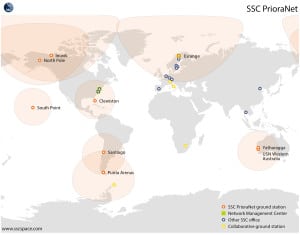Latest News
[Via Satellite 04-07-2016] Swedish Space Corporation (SSC), a company launched in 1972 that serves both the legacy and emerging space markets, is working actively to overcome “old space” tendencies ingrained in its culture and turn its attention to needs of small satellite operators. As a company that considers itself a legacy space business, SSC is looking to leverage its current ground infrastructure built for its “bread and butter” traditional Geostationary Earth Orbit (GEO) and Low Earth Orbit (LEO) satellite services. Tom Pirrone, executive vice president of the Americas for SSC, told Via Satellite the company had to work hard to pivot its business culture in order to figure out how to better serve new entrants.
“The biggest challenge for SSC in learning to work with small satellite companies has really been on our side of the table, not theirs,” said Pirrone. “We continue to find the need to disrupt our own way of thinking and to break our mental models that we have built so well over the years. Space companies like SSC, who have grown up in the past two decades, have to constantly evaluate and re-evaluate everything about our organizations. Do we have the right mentality to support this new and emerging marketplace? I would say that is a work in progress.”
The company currently operates a global ground station network that services more than 60 spacecraft a month and has ground stations located in the North Pole, Alaska, Hawaii, Sweden, Santiago de Chile, and Australia, among others. The network, known as PrioraNet, came about in 2009 after SSC acquired Universal Space Network (USN), a company it had previously been collaborating with to provide a global network of tracking stations to support on-orbit and launch communications needs. According to Pirrone, the ground network PrioraNet has been supporting small satellites since 2001, primarily on the NASA Small Explorer’s (SMEX) program, which focused on single-function satellites.
In 2014, the company recommitted “significant management time and resources” to tackling the needs of the emerging space industry and is now on the cusp of launching a new ground segment service tailored to SmallSat players.
While much about the expansion is still under wraps — with Pirrone pointing out that the company is planning to announce more details on the service, called SSC Infinity, within the next month — he did unveil that SSC would look to introduce a new business model that focuses on cutting costs for SmallSat operators.
“From the perspective of the commercial ground network, the big difference in what is needed to support the smaller satellite programs and the constellations of today is a much more cost effective approach to services. SSC has recognized this shift in the industry and is about to announce a new service that is dedicated to SmallSats and constellations with a new business model that takes full advantage of smaller antenna systems that are fully automated,” said Pirrone.
He also told Via Satellite that SSC would be expanding its network locations in a way that would specifically benefit the SmallSat market, and that new capabilities would be “cropping up” in South America, South Africa, Southeastern Asia, the Asia Pacific, Australia and New Zealand.
“We have a very large expansion planned for the Southern Hemisphere and Asia. These are very important regions of the world for our business expansion and specifically to meeting the needs of emerging small satellite markets,” said Pirrone, noting that collaboration would be a large part of the expansion of new SmallSat capabilities.
When configuring its network and capabilities to new LEO players, Pirrone said the services SSC provides for traditional GEO spacecraft are not too dissimilar from the needs of Non-Geostationary (NGSO) SmallSats. This is because the company does not cater much to the needs of established geostationary platforms except for one-off drift maneuvers, repositioning or decommissioning operations. Instead, it pulls the bulk of its business from orbit-raising services in the GEO market, during the Launch and Early Orbit Phase (LEOP) or Transfer Orbit Support (TOS) phases, as well as more “traditional” LEO missions, which make use of the company’s network services.
“SSC’s business in satellite tracking really prefers when the satellite is moving with respect to the Earth,” said Pirrone. “As long as the satellite is moving with respect to the Earth, we have an opportunity to provide our services.”
For this reason, he said that all of SSC’s antennas can cater to the SmallSat market.
“All of our antennas regardless of their size — and we do have antennas that are anywhere from 3 meters (small aperture) to 13 meters (large aperture) — each and every one has the ability to track an object in LEO, including a small satellite,” said Pirrone, adding that SSC is focusing on scaling back costs for the ground segment while scaling up its ground network, leveraging the company’s current ground infrastructure and introducing new services as a way to capture new business from both established and nascent markets within the satellite industry.
“Currently our commercial business, which is made of both emerging space and legacy programs, is on track to be our largest market sector and we are anticipating strong growth over the next five years. Of course there is still a bit of uncertainty in this marketplace, especially as new players execute their capital raising strategies, but we see several areas where the new, emerging players have a real shot at not just fundraising success, but also business success and profitability,” Pirrone said. “Of course it all remains to be seen, but with newer and cheaper ways of gaining access to space now a reality and with even more new players entering the launch market, we will continue to see a stream of new players trying to capitalize on the high ground of space.”
Get the latest Via Satellite news!
Subscribe Now
